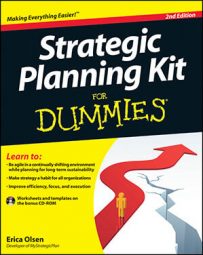Business owners have the unique responsibility of determining the strategic direction of an organization based on their personal endgame — the final result they want out of their business. An endgame can be anything from continual cash flow, to a business sale, to more time off, to changing the world. Basically, the endgame is the business owner’s personal vision.
Because your personal life and your business life are intertwined, you should have a BHAG (big, hairy, audacious goal) that runs in tandem with your corporate vision statement. This statement is called the owner’s vision statement and isn’t necessarily shared with your employees but is created specifically to develop a single focus point for all equity shareholders.
The great thing about being a business owner is you fully command the ability to lead a group of people to accomplish your dream or vision. More than likely, you started your business because you have a deep passion for doing something better or differently than everyone else.
Harnessing and communicating that passion can be two of the most powerful things in business, driving success beyond what you may think possible. Although we all know that it takes more than passion to have a successful business, often we lose sight of what originally sparked us to start our business in the first place.
Simon Sinek, author of Start With Why: How Great Leaders Inspire Everyone to Take Action (Portfolio/Penguin), reminds us that “those who inspire are not driven with what they do, they are driven with why they do it. Any organization can explain what it does; some can explain how they do it; but very few can clearly articulate why.”
As you think about your owner’s vision, reconnect with why you started your business in the first place. Why do you spend 60 hours a week doing what you do? What’s your endgame beyond money or profit, which are simply the results?
After you’ve answered these questions, identify what personal financial gain you want to see. Take out a notes page and label it “Owner’s Vision Statement.” List your ideas, consider when you plan to exit, how you plan to exit, how much return you want to see, and so on.
Many entrepreneurial businesses don’t have an owner’s vision because their founders haven’t looked at life outside of business ownership. An owner’s vision — even though it may seem far out — is imperative for anyone who’s founded or purchased a business.
Two schools of thought exist on how transparent owners should be with their endgame. One school subscribes to the idea that telling employees what you ultimately want to do with your business, specifically in the financial area, is too personal and may look greedy.
The other school adheres to the idea that the more people who share in the vision, the better. Depending on your management style and compensation structure, strike the balance that works best for you.
Regardless of your choice to share your end goals, do share your “why” so everyone — staff, customers, and partners — can connect with your passion, and you can build a strong strategic plan that reinforces your core purpose.
For a public example of an owner’s vision that leads with why and shares with everyone who interacts with the company, head over to Yoga to the People website and see its vision on the home page.

